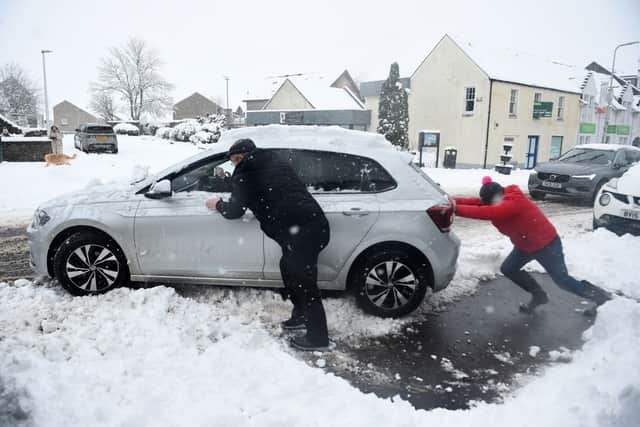Met Office storm names 2022/23: what are the new UK names for autumn and winter weather? Choices explained
and live on Freeview channel 276
The Met Office has revealed its list of UK storm names for the autumn and winter of 2022/23.
Applying to England, Wales, Scotland and Northern Ireland, the names are given to the most powerful storms that sweep in from the Atlantic Ocean. Last winter, Storm Eunice set the new record speed for a gust of wind in England - 122mph - and tore the roof of the O2 Arena in London, while Storm Arwen saw thousands of homes in the North of England and Scotland lose power for several days.
Advertisement
Hide AdAdvertisement
Hide AdExtreme weather events are set to become increasingly likely as the climate crisis progresses. Indeed, the Met Office has predicted a bad winter storm could be on its way next month.
Winters have been highly variable in recent years. In 2018, a severe Beast from the East struck the UK. While this winter has mostly been mild, extreme cold snaps have hit several times.
So, what are the names for the new UK storm season? Here’s everything you need to know.
What are the Met Office storm names 2022/23?
The Met Office has released 21 storm names for the upcoming autumn and winter period.
Advertisement
Hide AdAdvertisement
Hide AdTechnically they last until August 2023, but the worst storm systems have usually passed by the spring. They are named in partnership with Ireland’s weather forecaster Met Éireann and the Netherlands’ forecaster KNMI.


All of the Met Office and Met Éireann names on the list have been chosen by the general public. Here is the list for 2022/23:
- Antoni
- Betty
- Cillian (pronounced: KILL-ee-an)
- Daisy
- Elliot
- Fleur
- Glen
- Hendrika (pronounced: hen-DREE-ka)
- Íde (pronounced: EE-da)
- Johanna (pronounced: yo-HAH-na)
- Khalid
- Loes (pronounced: l-oo-s)
- Mark
- Nelly
- Owain (pronounced: OH-wine)
- Priya
- Ruadhán (pronounced: ru-AWE-on)
- Sam
- Tobias
- Val
- Wouter (pronounced: VOW-ter)


The letters Q, U, X, Y and Z are not used for names as the three European weather forecasters name storms in line with the US National Hurricane Centre naming convention. It means the letters storms take up remain consistent on both sides of the Atlantic Ocean.
This is important because the weather in the eastern Atlantic directly influences the weather of Ireland, the Netherlands and UK owing to the Gulf Stream.
What do the new storm names mean?
Advertisement
Hide AdAdvertisement
Hide AdWhile the UK entries for the storm names list are fairly self-explanatory, the Irish and Dutch entries might seem a little unusual. Those selected by the Dutch forecaster KNMI (Antoni, Hendrika, Johanna, Loes, Tobias and Wouter) relate to the Netherlands’ scientific pioneers. Here is who the names relate to:
- Antoni van Leeuwenhoek (1632 - 1723): known as the ‘father of microbiology’, he fine tuned the use of microscopes and was the first person to document microscopic observations of bacteria, sperm and red blood cells
- Hendrika van Leeuwen (1887-1974): a physicist and first female lecturer at Dutch university TU Delft
- Johanna Westerdijk (1883 - 1961): a botanist and fungal expert who became the first female professor in the Netherlands in 1917
- Loes van Straaten (1922 - 1991): a forestry expert in post-war Netherlands
- Tobias Asser (1838 - 1913): a lawyer who won the Nobel Peace Prize in 1911 for his role in establishing international legal mechanism the Permanent Court of Arbitration at The Hague in 1899
- Wouter Bleeker (1904 - 1967): a former chief of the KNMI described by the forecaster as a key figure in Dutch meteorology
What did the Met Office say about new storm names?
Introducing the new storm names, Met office head of situational awareness (a role that sets responses to severe weather events) Will Lang said: “We know from seven years of doing this that naming storms works. Last year, Storms Arwen and Eunice brought some severe impacts to the UK and we know that naming storms helps to raise awareness and give the public the information they need to stay safe in times of severe weather.”
A Met Office survey conducted in Storm Eunice red warning areas after the storm found 98% of people were aware of the warning, and 91% had taken action to protect themselves, their home or business. The Met Office has collaborated with Met Éireann since 2015 and the pair welcomed KNMI into the partnership in 2019.
Why was the last storm called Storm Otto?
The most recent storm to hit the UK was called Otto. This is because it was named by the Danish weather service due to it being forecast to become a categorised storm by the time it hit the Scandinavian country. While it caused significant disruption here in the UK, it was not deemed to be a fully categorised storm when it made landfall.
Comment Guidelines
National World encourages reader discussion on our stories. User feedback, insights and back-and-forth exchanges add a rich layer of context to reporting. Please review our Community Guidelines before commenting.
